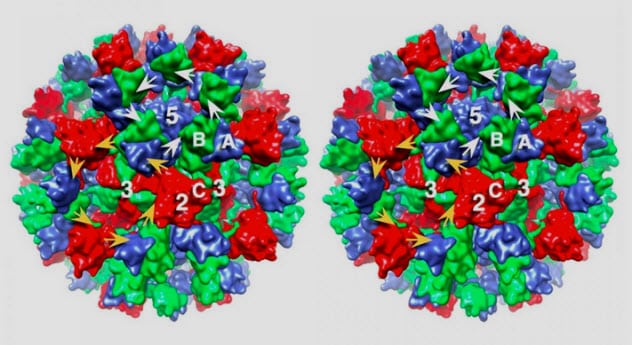 Movies and TV
Movies and TV  Movies and TV
Movies and TV  Mysteries
Mysteries 10 Mysterious Military Sites in America
 Weird Stuff
Weird Stuff 10 “Mysteries” That Prove We Live in Weird & Awful Times
 Animals
Animals 10 Terrifying Human Encounters with Swarming Animals
 Mysteries
Mysteries 10 “Ancient Alien” Artifacts That Have Mundane Explanations
 Miscellaneous
Miscellaneous 10 Everyday Terms with Surprising Historical Origins
 Humans
Humans 10 Genius Inventors with Highly Suspicious Deaths
 Weird Stuff
Weird Stuff 10 Weirdest Concept Car Designs Ever
 Movies and TV
Movies and TV The 10 Most Memorable Commercials of All Time
 Crime
Crime 10 Shocking Facts About the Electric Chair
 Movies and TV
Movies and TV 10 Actors Who Were Inebriated While Filming Major Movie Scenes
 Mysteries
Mysteries 10 Mysterious Military Sites in America
 Weird Stuff
Weird Stuff 10 “Mysteries” That Prove We Live in Weird & Awful Times
Who's Behind Listverse?

Jamie Frater
Head Editor
Jamie founded Listverse due to an insatiable desire to share fascinating, obscure, and bizarre facts. He has been a guest speaker on numerous national radio and television stations and is a five time published author.
More About Us Animals
Animals 10 Terrifying Human Encounters with Swarming Animals
 Mysteries
Mysteries 10 “Ancient Alien” Artifacts That Have Mundane Explanations
 Miscellaneous
Miscellaneous 10 Everyday Terms with Surprising Historical Origins
 Humans
Humans 10 Genius Inventors with Highly Suspicious Deaths
 Weird Stuff
Weird Stuff 10 Weirdest Concept Car Designs Ever
 Movies and TV
Movies and TV The 10 Most Memorable Commercials of All Time
 Crime
Crime 10 Shocking Facts About the Electric Chair
10 Viruses That Actually Help Humankind
Virus. The word is usually met with fear and understandably so. These microscopic collections of biological chemicals have been responsible for countless cases of death and sickness. The very mention of a deadly viral pandemic can send entire neighborhoods, cities, or even geographic zones into a state of sheer, frenzied panic.
Viruses are invisible to the naked eye, and they exist almost everywhere on Earth. They can infect fungi, plants, animals, and yes, humans. Some people have even speculated that viruses could pose a grave threat to the future of humanity.
However, not all viruses are bad. In fact, as we learn more about them, we are discovering that some viruses are actually quite beneficial. They have helped us in ways that we didn’t realize at first, and others pose interesting but positive possibilities for our future.
10 Bacteriophages

Bacteriophages are viruses that infect bacteria. They are found almost everywhere—in soil, in water, and even in the human body (mostly in our gut and mucus).
They were originally discovered in 1915 by Frederick Twort and have since become relatively famous in the field of microbiology as a therapeutic tool to help control bacterial infections.
While “phage therapy” is still under development, it is possible that it could be used in several different applications. It has already been used to treat some different types of ailments, and it shows great promise for the treatment of conditions ranging from cystic fibrosis to cancer. Some say that phage therapy also offers a viable replacement for traditional antibiotics in our age of antibiotic-resistant bacteria.[1]
9 There Is a Virus That Gives Plants Extreme Heat Resistance

Tropical panic grass has always had the ability to grow in soil with an unusually high temperature. Researchers have since discovered that the cause behind this unique ability seems to be a virus. A fungal endophyte grows on this grass, and a virus that infects this fungus seems to be the source of this heat-resistant power.
Even more interesting, scientists attached the virus to other plants, giving them the same ability. The researchers even managed to grow tomatoes in soil as hot as 60 degrees Celsius (140 °F) without killing them.[2]
But what happens if you remove the virus? They discovered that plants “cured” of the virus lost the ability to grow in extreme heat. Maybe that’s how the Human Torch does it.
8 Oncolytic Virus

Cancer—a word that causes dread in nearly every person affected by this potentially life-threatening disease. Doctors have sought different treatments and cures for the disease for more than 100 years; however, new interest has shifted focus to using viruses to treat cancer. And in recent years, a small but growing number of patients have begun to benefit from this approach. Research has shown that some viruses can infect and kill tumor cells. These viruses are known as oncolytic viruses and include viruses found in nature and viruses modified in the laboratory to reproduce efficiently in cancer cells without harming healthy cells.
Oncolytic viruses have long been viewed as tools for directly killing cancer cells. But a growing body of research suggests that some oncolytic viruses may work—at least in part—by triggering an immune response in the body against the cancer. When a virus infects a tumor cell, the virus makes copies of itself until the cell bursts. The dying cancer cell releases materials, such as tumor antigens, that allow the cancer to be recognized or “seen” by the immune system. For this reason, some researchers consider oncolytic viruses to be a form of immunotherapy—a treatment that harnesses the immune system against cancer.[3]
7 Adenoviruses

Adenoviruses are a group of fairly common viruses. They are extremely contagious, usually cause only mild symptoms, and generally go away within a few days.
Some of them are actually quite well known. Bronchitis, pneumonia, many stomach infections, colds, croup, and even meningitis can all be found within the adenovirus family.
But researchers have also learned that one particular strain of the virus, type 52 (HAdV-52), binds to a particular type of carbohydrate found in cancer cells. This creates some interesting possibilities for virus-based cancer therapy.
There is obviously more studying to be done. But in the future, scientists might be able to arm viruses with genes to help fight cancer. They may also be able to use viruses to activate the body’s own immune system to fight the cancer itself.[4]
6 Norovirus

Virologists have become especially interested in noroviruses. These particular micro life-forms are well known for their ability to cause epidemics of diarrhea on cruise ships. They are also infamous for their ability to ravage laboratory mice colonies with the disease.
But as it turns out, some strains of the virus have proven useful—especially for their role in helping to “normalize” mice that have grown in sterile environments. These mice don’t make enough T cells, which hurts their gut bacteria and immune response.
To fix the problem, researchers have shown that giving bacteria to the mice can help to rebalance their immune cells, but adding a norovirus to the mix can actually solve the same problem. Researchers also found that some norovirus strains helped lessen the effects of pathogens that usually cause weight loss, diarrhea, and other related symptoms in mice.
This makes for an exciting discovery as researchers unveil new ways to use viruses for good. Giving strains of the norovirus to humans to treat other diseases would be seen as highly controversial, but much evidence says that it could actually help.[5]
5 Ancient Retroviruses

Ancient retroviruses may be the reason we don’t lay eggs.
Scientists have yet to unravel the entire part that ancient retroviruses have played in human development. But some of them, technically referred to as “endogenous retroviruses,” are believed to have helped in the evolution of the placenta in mammals.
To put it in super simple terms, some scientists believe that a primitive human ancestor contracted an endogenous retrovirus that caused mutations in the genetic code. This eventually led to mammals being capable of live birth.[6]
The formation of the placenta was a huge step in the evolutionary process because it allowed mammals to give birth to live young. But when you take a really close look at the relationship between a mother and a fetus, it is not surprising that it shares many of the same characteristics you would expect to see in the relationship between a host and a parasite.
The work is ongoing. But don’t be surprised if we discover someday that the reason human females give birth to live babies instead of laying eggs is thanks to an ancient virus that altered our DNA.
4 Gamma-herpesviruses

This one is fairly technical, but it is no less amazing.
The Gammaherpesvirinae is technically a subfamily of herpesviruses that includes several different viruses. There are actually many different types of herpes viruses, with the best-known examples probably being herpes simplex virus type 1 and herpes simplex virus type 2, which cause cold sores and genital herpes.
As it turns out, latent infection with one type of gammaherpesvirus (type MHV-68) has been shown to increase resistance to infection with Listeria monocytogenes—the bacteria best known for food poisoning.
Who would have thought that herpes would help to fight food poisoning?[7]
3 Cowpox

This story actually begins with a dangerous virus called smallpox. Nobody is sure where it came from. But it is believed that even as early as the third century BC, it was afflicting the Egyptian empire. Records of it have been discovered in China from the fourth century, and it has basically shown up everywhere since.
It was a devastating disease that killed about 30 percent of infected people. Even those who survived were often left with terrible scars as a result of the ordeal.
But in 1796, an English doctor named Edward Jenner made a discovery. He noticed that milkmaids tended not to contract smallpox as often as everyone else. Soon, he realized that a similar virus called cowpox often spread from cows to the milkmaids and may have had something to do with it.
He tested his theory by inoculating a boy with material from a cowpox sore and exposing him to smallpox. Although it may sound like a shocking experiment, it was actually successful. This led to the practice of vaccination that ended up eradicating the smallpox virus two centuries later.[8]
2 GBV-C
 HIV is probably one of the most terrifying and infamous viruses of the 21st century. Nevertheless, another virus, GBV-C, has been getting some attention from scientists for its effect on those who are HIV positive.
HIV is probably one of the most terrifying and infamous viruses of the 21st century. Nevertheless, another virus, GBV-C, has been getting some attention from scientists for its effect on those who are HIV positive.
GBV-C is a member of the Flaviviridae family of viruses and can also be referred to as hepatitis G. The interesting aspect of this virus is its effect on the progression of HIV.
To put it simply, people who have both HIV and GBV-C tend to display a slower progression to AIDS and improved odds of survival—which is pretty amazing.[9]
Who would have imagined that the existence of another virus could possibly slow down a virus as dangerous as HIV?
1 The Arc Gene

Did you know that human consciousness may have originally been caused by a virus? Yes, it is possible, and here is why.
Researchers believe that a virus attached itself to the genome of one of our ancestors long ago—probably even before we walked on two legs. But they also believe that a tiny bit of the genetic coding contained within the virus still exists within our brains today and may be responsible for some serious “brainpower,” including consciousness itself.
The Arc gene is essential for the learning process in humans. Weirdly enough, it communicates by sending genetic material from one neuron to another using a process that is commonly seen in viruses.[10]
Further research must be done to determine exactly what this means. But right now, it looks as though it is very possible that we inherited our ability to learn and form conscious thoughts from the genetic material of some ancient brain virus!
Yes, the universe is definitely a weird and mysterious place.
Joshua Sigafus is just a writer who is trying to make the world a better place.
For more fascinating facts about viruses, check out Top 10 Mysterious Viruses and 10 Ways Parasites, Viruses, And Bacteria Have Helped Human Beings.








